Concept, meet application (in a narrow sense).
In our what is revenue marketing? article, we introduced many core concepts leading companies use in their marketing to be successful. If you haven't read that section as part of our topical introduction, head over there first!

Here, we delve into crucial details that leaders must think through – organizing for your modern marketing organization for success, whether on a regional, national, or global scale.
What is the optimal marketing organization for influencing revenue? What legacy silos of skills need to be dispersed and what new skill sets must be acquired to improve the customer experience?
Click to jump a section, or keep scrolling to get started:
Typical Models | A New Structure | Digital and Content | Demand Generation | Marketing Operations | Next Steps
Typical B2B Marketing Models
If, like me, you were in marketing in the 90s, we’re “old but not obsolete.” You may recall many B2B firms had marketing organizations that looked something like what's seen here.
That’s right: no marketing operations at all, and demand generation was part of the Marcom Director’s bailiwick which included PR, direct mail, events and “branding.”
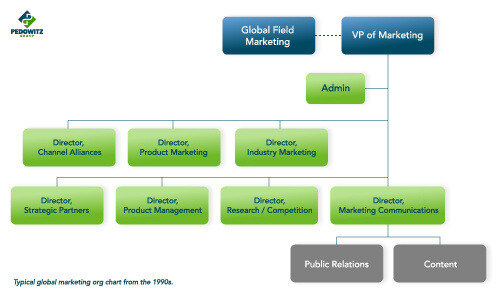
Fast forward 25+ years and we recognize the industry changes that lead to necessary updates in this structure:
- We now have multiple channels to engage prospects and customers, more than just sales contact, telemarketing, events and direct mail. And since the majority of these new channels are digital, we have “digital marketing groups.”
- We have an explosion of marketing technologies and customer data today, which benefits from having a team to govern these assets – Marketing Operations.
- We have increased pressures toward marketing accountability for revenue leading us to hire analytically-oriented individuals and data scientists.
- Content has become king. To drive engagement with our prospects we need relevant, educational content. This explains why content typically accounts for 25% or more of the budget.
An improved org chart
Let’s set aside the areas that have not changed much, but are still required: product marketing, product management, channel alliances, research/competitors, analyst relations.
Instead, let's focus our attention on the three newer areas as outlined above:
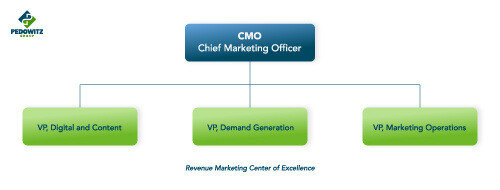
- Marketing operations
- Content and digital services
- Digital demand generation
These three teams could be grouped together into a Center of Excellence, providing demand generation, content and data services to a larger B2C or B2B global marketing organization.
Collectively, they:
- Create and execute demand generation plans to influence revenue
- Establish best practices, governance and standards for demand generation and optimization of marketing productivity through the use of people, process and technology
- Create and deploy content and campaigns to field marketing for localized execution
Let's dive further into each, starting with:
Digital and Content Groups
Yes, these are two groups, but often they roll up to one director or VP since there are strong ties between the two. The Digital group owns the website infrastructure and the social channels. The Content group has the designers, writers, production managers, the content strategists, and are responsible for all the raw content.
In many cases, they will depend on subject matter experts in other parts of the firm. Given the close working relationship between these two teams wherein one owns many of the channels and the other owns the content, it is logical to put them under one leader.
The charter of a Digital and Content group might look something like this:
Create compelling content to drive higher customer and prospect engagement resulting in more qualified leads for Sales. In addition, we will create a fluid customer experience, whether it is through inbound or outbound communications, to create one company feel.
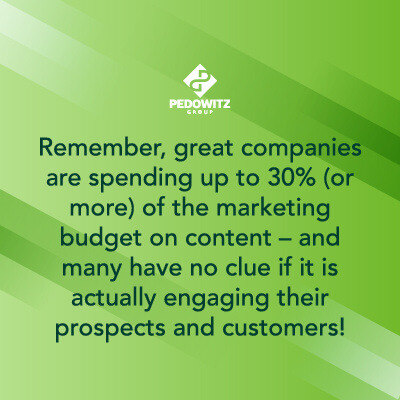
Notice the word “engagement” in there? Remember, great companies are spending up to 30% (or more) of the marketing budget on content – and many have no clue if it is actually engaging their prospects and customers! Are you measuring the level of engagement with each piece of content you produce today?
The Digital Content group is the source of the fuel for the Demand Generation engine. They build their roadmap based on input from the Subject Matter Experts (SMEs), product marketing, sales, requirements gathered from the Demand Generation team, field marketing, and other marketing teams.
If you agree with my premise that the website is also content, and as such belongs in a group where content in other media is created, then we arrive at an organizational crossroads:
- Do the search, display, and paid traffic gurus (or agencies) who are traditionally tightly linked to the website designers and producers also belong in this group?
- Or, since their function is really demand generation, do they splinter from their website production comrades and move into the Demand Generation group?
Suffice to say, most organizations have kept them in the same group…for now.
As marketing organizations shift toward building multi-channel campaigns to give prospects and customers a consistent cross-channel experience, it forces the inbound team ever closer to the marketing automation team in the Demand Generation group.
If you leave your inbound and social team in the Digital and Content group, ensure they develop a very tight relationship with the Demand Generation team since they will be working together more and more.
The Traffic Manager
I’m going to digress for a minute here, but I assure you this will have implications for the organization of the content group. Let’s talk about the life of an asset – a piece of content. You find a subject matter expert in the firm to write up a nice whitepaper (WP) and you put it on the website and you’re done, right?
Not so fast….
Developing the core content, the basis for the subsequent assets, is probably a third of the battle. These days, getting the value from the core content probably looks more like this:
- Get the core content developed and produce the first asset (WP for example)
- Write a blog post to promote the WP
- Write email copy to promote WP with outbound email channel
- Write landing page (LP) copy
- Write ad copy if you are going to do some display ads or paid search to promote WP
- Get a creative designer involved to add graphics and images for all the above
But wait! Now that you have development and creative around pone asset done, there’s more to do!
You have to plan out all the campaigns in all the channels to support this: email, blog, paid search, display ads, and social promoted posts. And we haven’t even begun to talk about splintering this fine piece of core content into tweets, infographics, bylined articles, slideshare, etc.
Someone needs to coordinate all these things so the LP is live with the WP, before the blog is published, and the display ad is created and ready right after the LP is live etc.
This is where the role of the traffic coordinator comes in.
There are multiple “campaigns” here through various channels, which may well use project managers for each (one for social, one for outbound, one for the website). It makes sense to have a traffic manager who organizes the development of all assets related to the core content. This person coordinates with all the channel-specific campaign project managers to ensure the promotions and campaigns all go live on time.
Traffic management isn’t just for agencies anymore, and it’s more work around a single piece of core content than you imagine. It is also an area of specialization in which many campaign project managers lack skills.
The Content Strategist
The Content Strategists engage with sales, field marketing, and the Demand Generation team to understand their needs for customer engagement. The content strategist combines the requirements from the disparate groups, adds their knowledge of the market segments, revenue targets, media trends, and produces a roadmap for content that will result in the greatest business result.
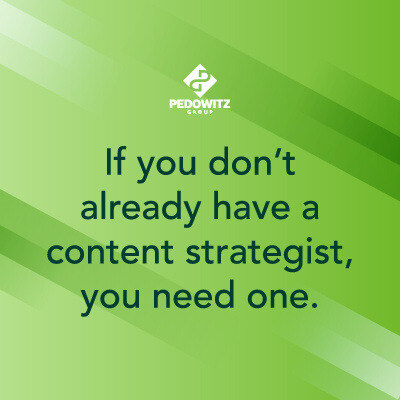
Not only does this person understand personas and buying cycles, their markets, and their products, the content strategist is an expert in determining what message is best delivered through which media; what is the right mix of freemium and premium content on the website; what mix of tools, templates, and research reports should be created? What assets will drive engagement in Korea, but not work so well in France?
The blog is also content. In your mind, is your blog more about content or more about being a channel? How do you leverage that content to greatest effect? Can you leverage a product or tool with helpful automation to help you channel externally-created, relevant content to your prospects through your Sales reps?
My point is, if you don’t already have a content strategist, you need one.
Budget
In my ideal world the funding for content development would come from the folks who have a revenue number in their goals: Sales, the Demand Generation group, field marketing, product line managers. This content group would excel at:
- Knowing how to create compelling content
- Driving consistent company and product messaging and positioning
- Engaging personas
- Knowing which media are best for delivering which message
- Spending their limited content budget to achieve maximum effect
- Knowing how to splinter content in one medium into multiple pieces for reuse
But the editorial calendar, the decision on where to spend the budget has to be strongly driven by the people who most need the content: Sales, Demand Gen, and field marketing. These three groups should not be in the position of trying to figure out how to use what the content group in HQ decided to produce. The three groups should be placing orders and getting exactly what they need to engage market segments. After all, they have a revenue number in their goals.
Get Started
Here are some ideas and priorities for organizing and leading a Digital and Content group for success:
- Decide on the charter for the Digital and Content team.
- Leave SEO/SEM folks close to the web designers/producers.
- Identify SMEs throughout the firm and get core content creation put into their job description and quarterly MBOs (Management By Objective).
- Setup systems to measure engagement with your existing content
- Define the role of traffic manager.
- Define a role for content strategist.
- Gather requirements from Sales/Channels, Demand Gen, field marketing.
- Be agile. Produce a 3-6 month calendar, not more.
- Distribute content to its maximum potential.
Demand Generation Group
Demand Generation comprises brand awareness building, thought leadership, lead acquisition, lead nurturing, loyalty marketing and advocacy. For a best-case team structure, include campaign strategists, campaign program managers, technology power users, analysts, PR strategists, inbound marketing experts (paid traffic and organic traffic) and outbound marketing experts (email).
You may be surprised to find the inbound team here instead of under the digital group described above. This is a recognition of the burgeoning unison of inbound and outbound in creating multi-channel campaigns. The two functions benefit from working in the same Demand Generation group.
We have a choice of channels for lead nurturing these days. We can now use retargeting through social channels, so we need to keep the inbound team tightly linked to the outbound team that has traditionally been used almost exclusively for nurturing.
Let’s dive in:
Team Charter and Structure
The charter of a Demand Generation group looks like this:
Responsible for driving revenue results and optimizing interactions with all global buyers across the revenue cycle to accelerate predictable revenue growth.
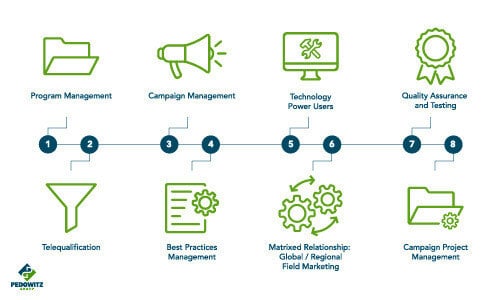
Consequently, in larger organizations you’re likely to see the following functions in this group outlined in the image.
(If that chart doesn’t scream a set of questions for you, it’s time for another cup of coffee!)
Program managers – top level business managers for marketing investment in Demand Generation – provide direction to the content team, and ultimately own the number that matters: marketing-influenced revenue.
Campaign managers take direction from the program managers. They’re often the same person in smaller firms and may specialize in one or more channels, but since campaigns are becoming omni-channel you’re better off having them focused by target market segment.
Campaigns are grouped by stages of the buying cycle by segment – awareness, lead acquisition, lead nurturing, customer loyalty, advocacy etc.
Marketing technology (MarTech) power users, quality assurance, and best practices management functions can fall into either the MO or Demand Gen team. Keeping them in Demand Generation means they continue to operate close to the Program and Campaign Management teams.
On the other hand, if your MO function is well developed, putting them in the shared services group in MO means they are close to analytics and project management. This means this team will probably have a more streamlined relationship with the field marketing team, i.e. the “HQ” region is less likely to dominate the global campaign calendar unless the revenue goals merit it.
Tele-qualification is often both in marketing and sales. If the line is blurry, that’s good … it should be! The function is squarely on the line between the two organizations. If you use them to sell smaller deals, renew contracts, etc, then they probably belong in sales, and are rightfully described as an Inside Sales function. But if the function is strictly to provide higher-quality leads to sales, driving up sales’ productivity, then keep them in marketing.
A (Necessary) Inbound vs. Outbound Digression
There are more internet battles on inbound versus outbound than about Kirk versus Picard! (Okay, I may be slightly exaggerating).
Some say inbound is less expensive than outbound for lead generation or that outbound is marketing to the masses (TV commercials, radio, email blasts, tradeshows). Is inbound just content marketing using SEO, and paid traffic through online channels?
By all means, fire your takes at me on LinkedIn, but here is my perspective: It's not news that the line between the two continues to blur, so marketers need to move past these debates, unite these teams, and start designing and executing multi-channel (or omni-channel, depending on industry) campaigns.
When we put ourselves in our prospects’ shoes we recognize that they want to engage with us via multiple channels: TV, mobile, web, social channels, email etc. They want our communications to be consistent, and to show some memory of the past interactions we had with them in the various channels. Finally, I hear you murmur, a hint about how this digression is relevant to the organization of a Demand Generation group… So organizing your marketing into siloes based on their digital channel speciality – web team, social team, email team, PR, etc. is not such a great idea anymore.
Imagine a campaign that starts with a promoted blog post on Facebook, points to a piece of premium content on the web, which is viewed on a mobile device, encourages the prospect to visit a store and scan a QR code (yes, those are relevant) on a shelf driving them to a microsite, and triggering a follow up email the next day, a remarketing campaign hits a week later, and a tele-prospecting call a week after that.
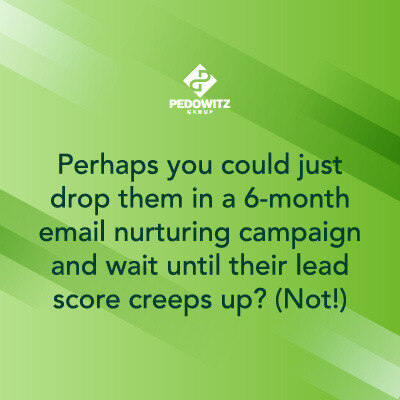
Or, perhaps you could just drop them in a 6-month email nurturing campaign and wait until their lead score creeps up? (Not!)
I’ve made the case that the inbound team should be treated like the outbound team and deserve to be in the Demand Generation Group:
- The Facebook, LinkedIn, Google, Twitter, Instagram “power users” should become part of the “power user group” along side the marketing automation power users.
- Paid traffic campaign managers will become the same people who leverage outbound channels in their omni-channel campaigns.
- Campaign project managers need to be skilled in managing assets and resources for omni-channel campaigns, combining inbound and outbound channels.
Is using social channels for remarketing to leads you already have relationships with really inbound marketing?
Who cares? It is good Demand Generation marketing, and your prospects may prefer to engage with you through that channel versus through email.
Get Started
The marketing industry goes through significant changes every couple of years, it seems. New media reshapes the buying process and requires us to continually evolve selling and marketing processes.
The Demand Generation group’s ability to execute relevant engagement with prospects requires technology, clean data, optimized processes and constant feedback from all prior interactions regardless of the channel. This drives us towards putting the teams that drive engagement under one global Demand Generation leader.
Here are a few steps outlining how to reorganize to do this:
- Decide on the charter for the Demand Generation group.
- Research and select what channels work best for your firm based on where your prospects engage…not your preconceived ideas about where they are.
- Start to plan omni-channel campaigns.
- Create a unified campaign development process that works for all channels.
- Create campaign briefs and blueprint templates that support omni-channel campaigns.
- Start education of your MAP power users on inbound marketing (high level).
- Start education of your inbound channel team on the funnel, on MAP, and on CRM.
- Train several project managers on how to manage both inbound and outbound and ultimately manage omni-channel campaigns.
- Now you can start to merge the teams…do so by creating omni-channel SWAT teams that consist of inbound, outbound, power users, and project managers.
Marketing Operations Group
You'll want to go into a deeper dive into this with Dr. Debbie Qaqish and Realizing More Value In Your Marketing Operations, but we'll touch on it here as well.
Marketing Operations centralizes the management of technology, process, data and marketing analytics. There is widespread belief that this centralization makes marketing more efficient, effective, transparent and accountable.
The roles one finds in operations include analysts, competitive intelligence, data management, project management, marketing technology and vendor management, training, and process experts. Occasionally, we've also seen firms put the technology power users into this group so they become a centralized service to the demand generation and field marketing groups.
Marketing Operations Maturity
Some larger organizations have had centralized Marketing Operations for 10+ years, while others, usually smaller organizations, have either had the functions decentralized in marketing or they appointed a single manager or director to the role, with no direct reports.
This range of organizational structure is due to the varying maturity levels of Marketing Operations within companies:

Initially, MO may be a decentralized set of reactive responsibilities for technologies and perhaps metrics.
In the most mature case MO is a centralized function, the source of data and insights for leadership decision making, the focus of customer experience information, and the basis for marketing productivity, agility and accountability.
Where are you on the maturity curve? Our consulting services can assess and tell you!
Why Centralize Marketing Operations?
The MO function continues to evolve, but current responsibilities fall into the following broad areas:
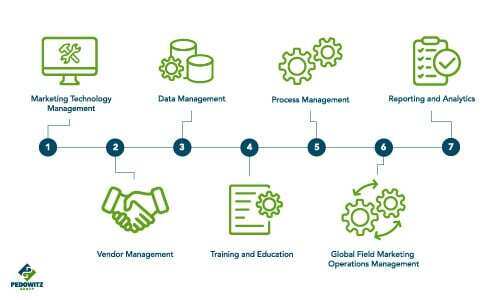
- MarTech strategy, selection, integration and optimization
- Vendor management
- Data management, governance and optimization
- Process engineering and optimization
- Measurement, analytics and reporting
- Project management, training and education
- Change management
- Perhaps a global shared services group for campaign execution and content operations
We typically see firms move beyond the decentralized MO function and start to centralize when the following potential benefits begin to demand organizational change.
- Increased marketing efficiency and organizational agility
- Faster adaptation of marketing efforts in response to changing customer behavior, market conditions and business direction
- Improved revenue, margin, profit and market share
- Underpinning a shift from marketing being managed as a cost center to operating more like a business, with formalized best practices, processes, infrastructure and reporting
- Leveraging data to make market, customer, and product/service decisions that create value for customers and shareholders
The Usual Marketing Operations Evolution
The MO group will usually start with a focus on getting their arms around the ever growing set of marketing technologies. Then quickly they will recognize that this has to be done in the context of the data and the related processes. And it doesn’t take long until reporting, finance, project management and training get added to the mix.
Learning to operate marketing as a business, with revenue accountability, processes, reporting and the related optimization mindset can be a significant shift for marketers who were used to operating as a creative cost center with no revenue responsibility.
That’s why change management becomes part of MO, because you won’t get there unscathed if you don’t manage the shift effectively!
Get started
Your new hires, after a Director of Marketing Operations, are in the following order:

- Technologist – someone who can set the direction, lead governance and integration initiatives. They also take on vendor management.
- Data whiz. I am fraught to say data scientist because that may be overkill for smaller organizations, but that is where this role goes in larger organizations. Leverage this person for all reporting and analytics too.
- Outsource much of the process re-engineering – most firms won’t need a full time equivalent (FTE) to cover this role.
- Outsource your training, but don’t underestimate the value of it.
- Borrow project management resources from IT until the team has so many initiatives you need your own FTE.
MO depends on finding people who are both left-brain and right-brain. They can be analytical, but also creative. They are the marketing unicorns. They are getting harder to find because MO is growing so quickly. But this is an important milestone in your journey, so please invest proper time and resources to set this group up with a great charter, and the right skill sets.
Conclusion
The division of functions between these three new groups (Digital/Content, Demand Generation, Marketing Operations) is not always clear.
A guiding principal for determining where a team should live is whether they offer a function that is infrastructure- and support-related rather than day-to-day engagement campaign or content creation related. For instance: Is the website regarded as mostly infrastructure, demand generation, or content?



